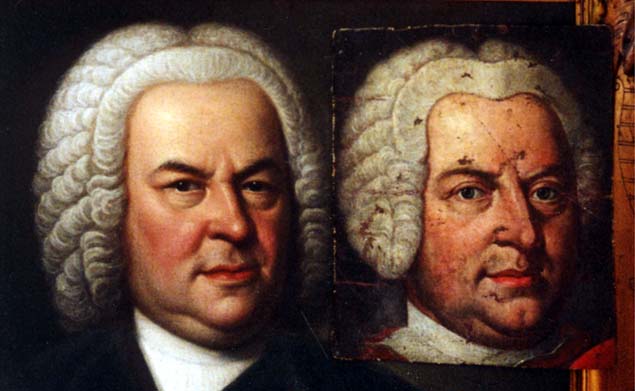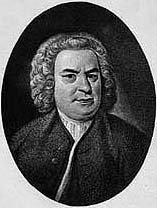The Present Day Misconceptions About Bach Performance Practice in the 19th Century - The Evidence of the Recordings Pages at the Teri Noel
Towe Home Pages - Page 4 - Sir Adrian Boult and Sir Eugene Goossens
Johann Sebastian Bach
Present Day Misconceptions
About Bach Performance Practice in the Nineteenth Century
The Evidence of the Recordings
This remarkable photograph is not a computer generated composite; the original of the Weydenhammer Portrait Fragment, all that
remains of the portrait of Johann Sebastian Bach that belonged to his pupil Johann Christian Kittel, is resting gently on the surface
of the original of the 1748 Elias Gottlob Haussmann Portrait of Johann Sebastian Bach.

1748 Elias Gottlob Haussmann Portrait, Courtesy of William H. Scheide, Princeton, New Jersey
Weydenhammer Portrait Fragment, ca. 1733, Artist Unknown, Courtesy of the Weydenhammer Descendants
Photograph by Teri Noel Towe
©Teri Noel Towe, 2001, All Rights Reserved
PRESENT DAY MISCONCEPTIONS
ABOUT BACH PERFORMANCE PRACTICE IN THE NINETEENTH CENTURY
THE EVIDENCE OF THE RECORDINGS
Page 4
Sir Adrian Boult and Sir Eugene Goossens
This essentially early 19th-century approach to the music of the greatest of the Thomascantors was passed on by
Mendelssohn-Bartholdy, David, Hauptmann, Robert Schumann, Ignaz Moscheles, and Carl Reinecke, among others. All of these
men were members of the faculty of the Conservatory in Leipzig that Mendelssohn-Bartholdy and Schumann founded in 1843 (now
the Hochschulwe für Musik Felix Mendelssohn-Bartholdy). In fact, Reinecke, who had studied with both Mendelssohn-Bartholdy
and Schumann in Leipzig in the mid-1840s, was still an active member of the faculty at the Conservatory in Leipzig at the time of his
death on March 10, 1910.
An excellent school of an essentially conservative outlook, the Leipzig Conservatory had a special appeal during the late 19th and
early 20th centuries to British music students, for whom, of course, the link to Mendelssohn-Bartholdy was important for other
reasons. Among them were Sir Arthur Sullivan, Frederick Delius, and Sir Adrian Boult, who attended the Conservatory in 1912 and
1913.
But, by his own testimony, Boult had been exposed to the Leipzig school of Bach playing nearly a decade earlier, at the age of 15.
The experience remained vivid in his memory for the rest of his life. In the preface, dated July 3, 1973, to his EMI recording of the
Brandenburg Concertos, BWV 1046-1051 [16], he wrote:
"I shall never forget my first hearing of the Third Brandenburg Concerto. It was on December 15, 1904, by the newly
formed London Symphony Orchestra, conducted by Fritz Steinbach of Cologne (who had previously conducted a
performance by the Meiningen Orchestra in St. James's Hall in 1902). Every string player was used and they were set
out in four rows (two for the violins) with the first player in each department on the left, radiating round to the third
group, with the basses in the middle at the back. Steinbach's edition of the Concerto (Eulenburg) is full of expression
marks (the rise and fall of each scale in the last movement is a good example) which were not, however, overdone in
my opinion. There was a splendid robust rhythmic swing throughout, and it was noticeable that the strong accents
were widely spaced (and there were not too many of them) so that the music went with a sweep, not unlike Hans
Richter's (though with far greater intensity of detail). Most important of all, however, was the smooth string playing
with no daylight between notes anywhere: a vigorous legato firmly sustained with no sign of the Bach staccato that
became a cult thirty years later. . . .
So these performances of the wonderful six concertos are taking our audience back to the Bach of 1900, to the
smooth solid expression given by a far larger orchestra than Bach could ever contemplate. . . ." [17]
Clearly, when he recorded the Third Brandenburg Concerto (first movement; quarter note = 88 to 90 at the beginning, slowing to
quarter note = 86 to 90 at bar 9); duration: 6 minutes, 17 seconds; third movement: dotted quarter note = 80; duration: 4 minutes, 55
seconds), Boult remembered the conducting of Steinbach well, for his description of the 19th-century German conductor's
performance not only fits his own like a glove, but also his forthright gramophonic and written recollections tally with the remarks
made by one of the London critics, who wrote of one of Steinbach's frequent appearances with the London Symphony Orchestra
that the conducting was "decidedly strenuous, but, at least, the virtue of this fault enabled him to develop superb climaxes." [18]
Steinbach (1855-1916) studied at the Leipzig Conservatory in 1873, and was the conductor of the renowned orchestra of the Grand
Duke of Meiningen, which Brahms's good friend Richard Mühlfeld was the principal clarinettist. In addition to championing the
music of Bach, Steinbach was renowned for his conducting of Brahms, who, in addition to being himself a fervent Bach admirer,
was yet another profoundly influenced by members of the Leipzig school, through both Joachim and Schumann.
Boult's recordings of the Brandenburg Concertos were not his first gramophonic encounter with the music of Sebastian Bach. In
the early 1930s he made one of the first recordings of the Ouverture No. 3 in D Major, BWV 1068. [19] That recording displays
the same interpretive traits as his account of the Brandenburgs. Still, one is entitled to wonder just how much the myriad, radical
developments that took place in all aspects of performance practice during a period of almost 70 years had affected his ability to
"take our audience back to the Bach of 1900."
As it happens, Boult's younger contemporary, Sir Eugene Goossens (1893-1962), made the first recording of the Brandenburg
Concerto No. 3, for HMV, in 1922. (first movement: = 86 to 90; duration: 6 minutes, 27 seconds; third movement: = 68 to 70;
duration: 3 minutes; 43 seconds [Goossens observes only the first repeat in this movement, unlike Boult, who observes both.]) [20]
His reading is, essentially, the twin of Sir Adrian's, particularly in the first movement, in which their choices of basic tempo are
identical for all practical purposes. [21] Goossens never studied at the Leipzig Conservatory, it is true, but he was a pupil of Sir
Charles Villiers Stanford, who had been a composition student of Carl Reinecke's at the Leipzig Conservatory in 1875 and 1876. In
addition, one cannot help but think that, as a student in London from 1907 onwards, Goossens heard Steinbach and Hans Richter,
among others, conduct.
But neither the Boult nor the Goossens Bach recordings are well known, even among the cognoscenti, and no one has stopped to
consider their value as evidence of past Bach performance styles. On the other hand the performance of the Brandenburg
Concerto No. 3 recorded by the Berlin Philharmonic under the direction of Wilhelm Furtwängler -- monumental, regal, slow,
texturally thick, and chockerblock full of tempo fluctuations -- (first movement: = 78 to 82 as a basic tempo; duration: 7 minutes, 9
seconds; third movement: = 76 to 78 as a basic tempo; duration: 3 minutes, 17 seconds [Like Goossens, Furtwängler does not
observe the second repeat in this movement.]) [22] is quite well known, in no small measure because it is the interpretive handiwork
of a revered conductor who is deservedly a cult figure. Yet, because Furtwängler was a towering personality who left his indelible
stamp on every work he touched, his readings cannot be construed as representative of the mainstream any more than the peculiarly
beautiful visions of Mengelberg can be.
For both of those men, to use the words attributed to their colleague Arturo Toscanini, tradition was the memory of the last bad
performance. In his own way, each did much to reshape both interpreters' and listeners' attitudes towards performance practice,
and neither did anything to hinder the destruction of longstanding performance conventions that took place in Europe during the
1920s and '30s. Their actions were not malicious, of course; in fact, they were subconscious. All that Furtwängler and Mengelberg
were doing was interpreting the music to the best of their extraordinary abilities. They were musical liberals, not conservatives.
To posterity, it seems, Boult and Goossens are not on the same level of greatness as Furtwängler and Mengelberg, yet their work
may well tell us much more about the work of their genius predecessors, whether liberal or conservative, who did not make records
but who set the standards or maintained them in their own times. Thus, when trying to determine what the 19th-century's approach
to the performance of Bach's music really was we ought not to accept the performances of Furtwängler, Mengelberg, and
Stokowski as the paradigms, but rather study and absorb the style practiced by Joachim, Ochs, Weisbach, Goossens, and Boult,
with its generally fast tempos, long phrases, and relatively straightforward expression.
But, why, you may rightly ask, is the resolution of this question important, especially at a time when the Bach scholarly community
is justifiably concerned with trying to reconstruct as accurately as possible his own performance practice?
Please click on  to advance to Page 5 - Why An Understanding of What Nineteenth Century Bach Performance
Practice Actually Was Is A Matter of Crucial Importance at the Beginning of the Twenty-First Century.
to advance to Page 5 - Why An Understanding of What Nineteenth Century Bach Performance
Practice Actually Was Is A Matter of Crucial Importance at the Beginning of the Twenty-First Century.
Click on  to return to the Johann Sebastian Bach Index Page.
to return to the Johann Sebastian Bach Index Page.
Click on the  to return to the Teri Noel Towe Welcome Page.
to return to the Teri Noel Towe Welcome Page.
teritowe@alumni.Princeton.EDU
Copyright, Teri Noel Towe, 1985, 1986, 1988, 1989, 2001
All Rights Reserved
The Present Day Misconceptions About Bach Performance Practice in the Nineteenth Century - The Evidence of the Recordings
Pages at the Teri Noel Towe Home Pages
are PPP Free web pages.

The Present Day Misconceptions About Bach Performance Practice in the Nineteenth Century - The Evidence of the Recordings
Pages at the Teri Noel Towe Home Pages have received
the HIP Woolly Mammoth Stamp of Approval from The HIP-ocrisy Home Page.